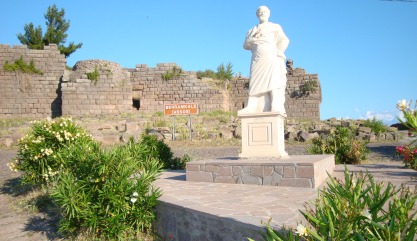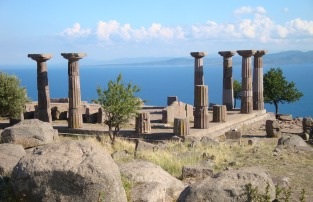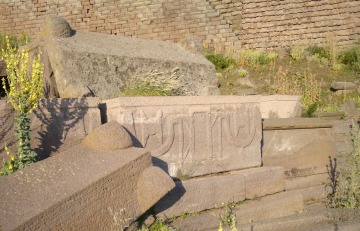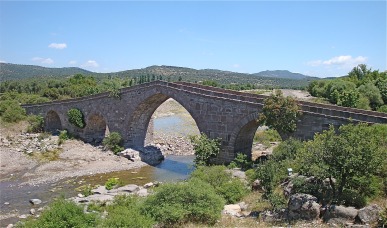The Troad’s two-in-one beauty spot Population: Less than 2,000
Most famous resident: Aristotle
Assos is a place whose attractions catch you unawares.
Driving in from Ayvacık or Gülpınar, you come to a road junction where you need to pause and make a choice. Turn left uphill and you’ll came to Behramkale (Behram’s Castle), the pretty little stone village which is modern “Assos”, the houses straggling uphill until eventually they peter out below the ruins of a Temple of Athena poised to scoop the views across to Greek Lesbos (Midilli).
Keep driving straight ahead and downhill instead and you will pass stretches of Roman wall and the site of the old Roman theatre before arriving in a place of breathtaking beauty – Assos harbour (liman) where half-a-dozen elegant stone warehouses have been converted into hotels. That and a few bars and cafes is all there is. It’s a glorious spot, one of the prettiest in all Turkey.
Tip: Avoid visiting Assos over weekends or during Turkish school holidays as everything will be absurdly overpacked. This is also a popular place for school groups to visit after exams in early June.
Backstory
Once a city important enough for St Paul to visit it on his third missionary journey, Assos never recovered its early vibrancy and slid into a steady decline from which it has only really recovered in the last twenty years. From the long centuries of the Middle Ages and early Ottoman times, only a mosque and bridge survive.
Inside the walls of ancient Assos an interesting experiment was carried out in the fourth century BC when Hermias, a eunuch pupil of the Greek philosopher Plato, gained power and decided to put into practise some of his teacher’s ideas about the perfect city-state. To help him in his endeavours he invited Aristotle to come and live here from 347 to 344, a period during which he became so enamoured of Assos that he wound up marrying Hermias’ niece Pythia.
Unfortunately for the philosopher-kings the Persians still had their beady eye on Western Anatolia. As they descended on Assos Aristotle fled to Lesbos; poor Hermias was tortured to death.
***In April 2021 it was announced that the Assos historical sites would close for 500 days while work was carried out to strengthen and stabilise the hillside. I don’t know if the work has been completed.***
Around Behramkale
Right at the top of the path through Behramkale stand the dramatic if relatively slight ruins of a Temple of Athena dating back to 540 BC and featuring some clumpy and unusual (for Turkey) Doric capitals built out of volcanic andesite. It was erected by settlers from Lesbos who dropped anchor here in the eighth century BC and once boasted a decorative frieze that is housed in the İstanbul Archaeology Museum. More impressive than the actual ruins is the spectacular view out across the Gulf of Edremit to Lesbos.
 Just below the ruins stands the Hüdavendigar Cami that incorporates bits of masonry taken from a 6th-century church in its walls. Built during the reign of Murat I Hüdavendigar (1359-89), it’s a simple mosque built to an early Ottoman design that can also be seen in Bursa.
Just below the ruins stands the Hüdavendigar Cami that incorporates bits of masonry taken from a 6th-century church in its walls. Built during the reign of Murat I Hüdavendigar (1359-89), it’s a simple mosque built to an early Ottoman design that can also be seen in Bursa.
Leaving Behramkale for Ayvacık you will pass the graceful 14th-century humpbacked Ottoman Hüdavendigar Bridge which is contemporary with the mosque.
Around the harbour
Following the winding path down to the harbour you will have the sea on your right and the shattered walls and defensive towers of ancient Assos on your left.
Eventually you will see, beyond the walls, the remains of a large necropolis once filled with the supposedly flesh-eating sarcophagi for which Pliny claims the town was famous. 
Roughly halfway down the hill a gate permits access to the ruins of ancient Assos. The most conspicuous structure is a theatre which dates back to the third century BC and which would have allowed its patrons to enjoy a panoramic view out to sea while they lapped up the entertainment.
Other ruined structures in the vicinity include an agora (marketplace) and stoa (colonnaded walkway), but they are far less easy for a lay person to make out.
Returning to Behramkale, if you divert into the fields to the left of the road before you get to the crossroads you’ll also find the remains of a sizeable basilican church.
Although the hotels in the harbour have an idyllic location, they are not as luxurious or well-equipped as you might expect, having been turned into hotels before the modern boutique hotel movement got into its stride.
The harbour hotels usually require you to take a half-board package, including breakfast and dinner. All the cheaper accommodation is in Behramkale.
Assos Konuk Evi, Behramkale. Tel: 0286-721 7081
Biber Evi, Behramkale. Tel: 0286-721 7410
Eriş Pansiyon, Behramkale. Tel: 0286-721 7080
Hotel Assos, Assos. Tel: 0286-721 7017
Hotel Assos Kervansaray, Assos. Tel: 0286-721 7093
Hotel Nazlıhan, Assos. Tel: 0286-721 7385
Yıldız Saray Hotel, Assos. Tel: 0286-721 7025
Old Bridge House, Behramkale. Tel: 0286-723 7100
 Hüdavendigar BridgeTransport info
Hüdavendigar BridgeTransport info
Buses run from Çanakkale to Ayvacık where you change to a minibus to Assos/Behramkale (25km). There are infrequent onward dolmuş services from Behramkale to Ezine (for Bozcaada) and Küçükkuyu (passing Kadırga). Local buses also connect Behramkale with Gülpınar and Babakale.
Finding a dolmuş down to Assos harbour except in high season is likely to prove tricky. It’s a wonderful walk down, with sweeping sea views all the way. Climbing back up again is for the young and fit only.
Day trip destinations
 The Temple of Athena probably looked like this originally
The Temple of Athena probably looked like this originally

